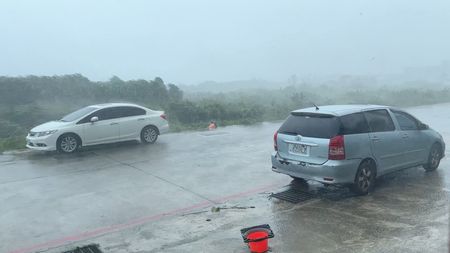By Jessie Pang, Joyce Zhou and Joe Cash
HONG KONG/BEIJING (Reuters) -Tropical storm Podul on Thursday dumped torrential rain on southern China, still reeling from record downpours last week, and disrupted hospitals, schools and law courts in Hong Kong after tearing through Taiwan and leaving 143 people injured.
The hearing of Hong Kong media tycoon and pro-democracy advocate Jimmy Lai was cancelled after authorities put in place their highest-level “black” rainstorm warning, as supporters queued under umbrellas outside the court. Out-patient clinics also shut until 2 p.m. (0600 GMT), and schools closed for the day.
Meanwhile, airports across the region reported cancellation rates for the morning of around 20%, according to data from Flightmaster, as Podul pelted parts of the Chinese provinces of Guangdong, Hunan and Jiangxi with more than 70 mm (2.76 inches) of rain an hour.
Over a third of flights to Quanzhou – a key textile, footwear and apparel export hub – were cancelled, with analysts warning extreme weather events increasingly pose a threat to growth in the world’s second-largest economy.
China has been battling with record rainfall in its north and south as well as prolonged heatwaves in its interior. The government on Thursday announced 430 million yuan ($59.9 million) in fresh funding for disaster relief, taking the total allocated since April to at least 5.8 billion yuan.
“It’s been raining constantly, and raining really heavily,” said Cara Liang, a 25-year-old visitor to Hong Kong from China’s neighbouring Guangdong province.
“Many places in mainland China have experienced flooding, which hasn’t been good for anyone. My trip to Hong Kong this time has been completely disrupted,” she told Reuters in the Asian financial centre’s business district.
Podul made landfall on the coast of China’s southeastern province of Fujian at 00:30 local time (1630 GMT Wednesday), having weakened from a typhoon to a tropical storm after lashing Taiwan on Wednesday, where winds of up to 191 kph (118 mph) left one person missing and scores injured.
But its residual vortex stands to wreak havoc in southern China, still reeling from the heaviest rains in generations last week, as it moves northwest at a speed of 30-35 km per hour (19-22 mph).
Hong Kong saw its heaviest August rainfall since 1884 last week, while in Guangdong, 75,000 people were evacuated as 622.6 mm (24.5 inches) of rain fell on the provincial capital Guangzhou between Aug. 2 and 6 – nearly three times the city’s August average – leaving at least seven dead.
“Authorities need to be extra ready,” said Chim Lee, a senior analyst at the Economist Intelligence Unit. “There’s growing evidence that we’re seeing more intense and slower-moving tropical cyclones.
“China’s southern coast is set for economic disruptions of all kinds. Most institutions in the region are fairly well prepared, but there also seems to be a subtle northward shift in where cyclones reach their peak intensity – these places need to keep a sharper eye out.”
Over one million cubic meters of water, the equivalent of 400 Olympic-sized swimming pools, was discharged from a reservoir in eastern Guangdong on Wednesday to free up space in anticipation of further heavy rain, state media reported.
Authorities in Guangdong’s Meizhou closed all the highways on Thursday morning due to the downpour, and the high-speed railway linking the high-tech hubs of Shenzhen and Hangzhou in eastern Zhejiang province, some 1,200 km (745 miles) away, was suspended.
($1 = 7.1705 Chinese yuan renminbi)
(Reporting by Jessie Pang and Joyce Zhou in Hong Kong, Joe Cash in Beijing and Ben Blanchard in Taipei; Writing by Joe Cash; Editing by Michael Perry and Lincoln Feast.)








